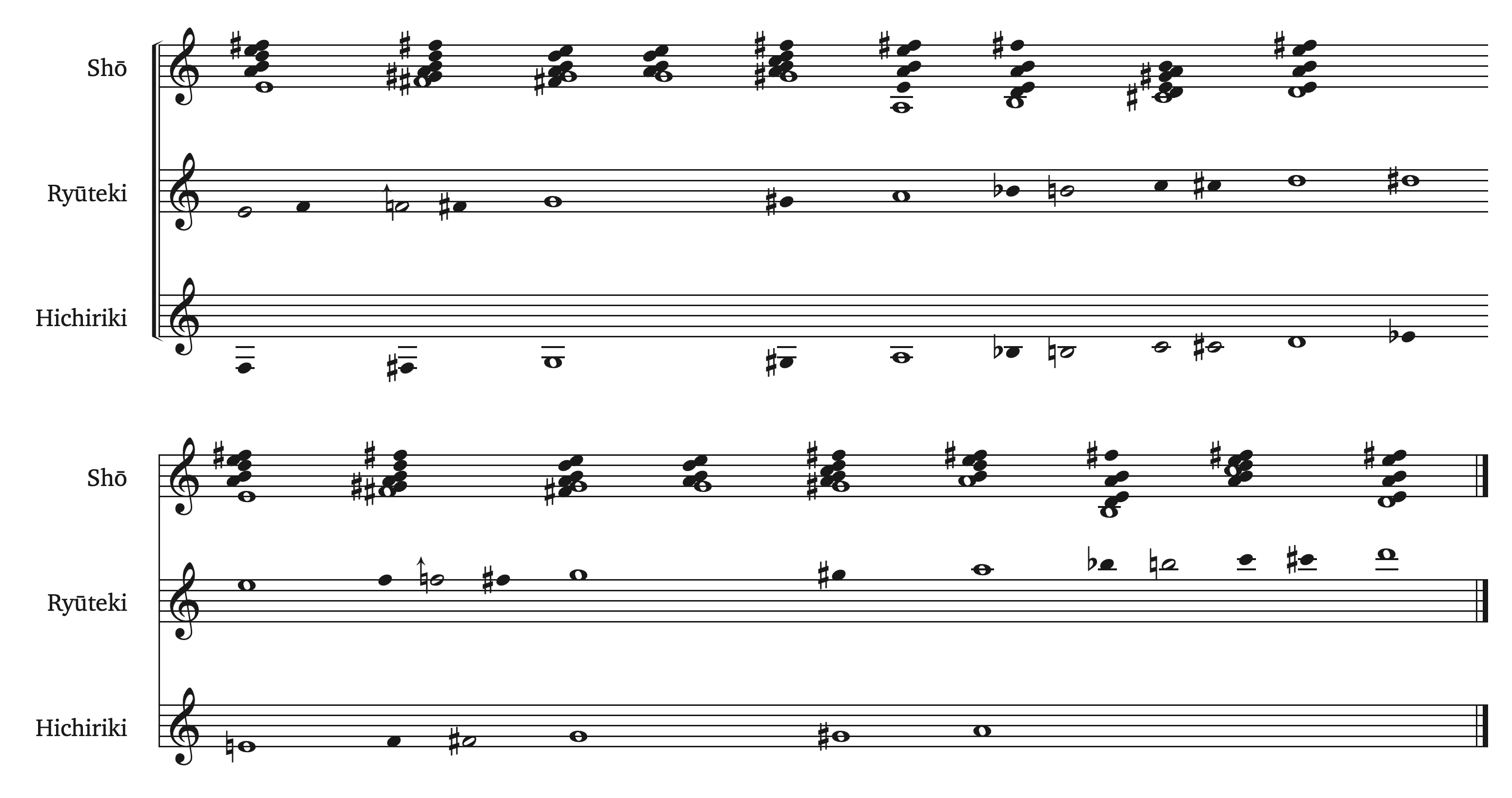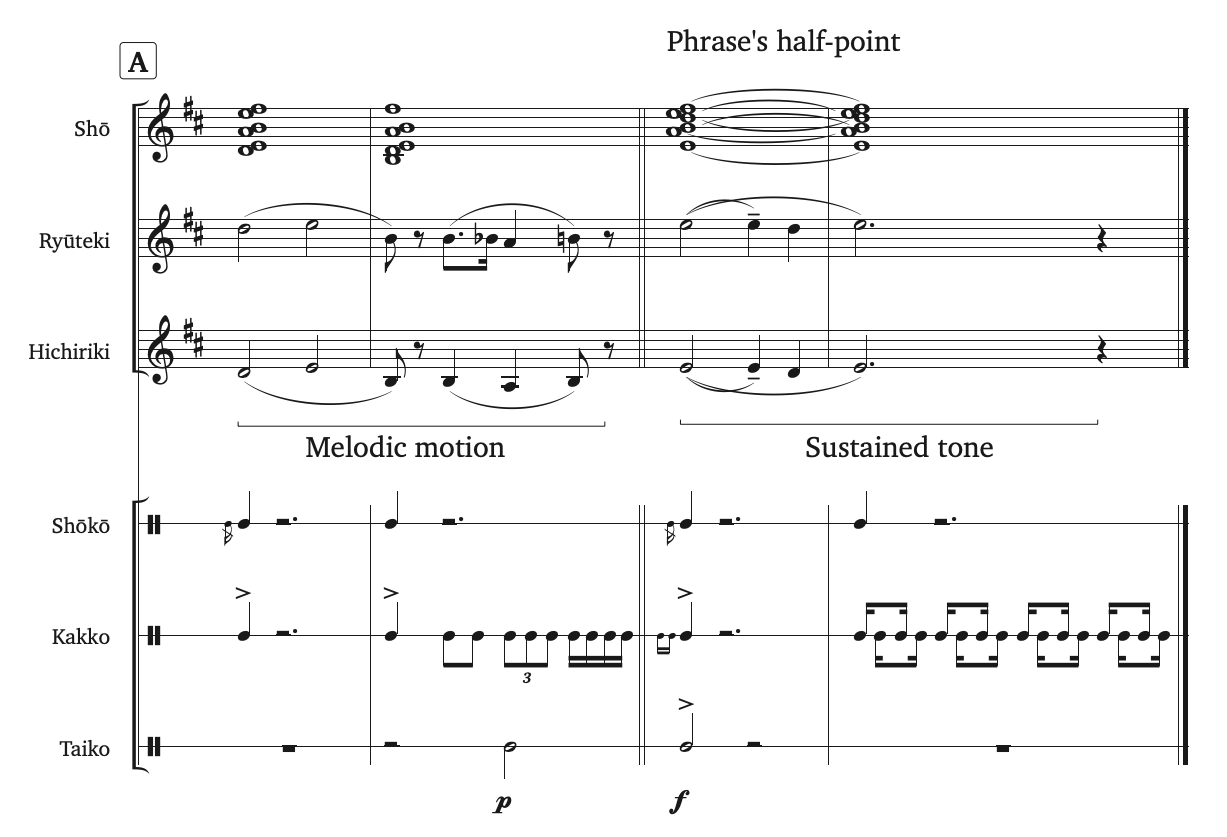Mixing the woodwind instruments
The function of the ryūteki and hichiriki is to present the melody. The two instruments typically voiced in octave, play in heterophony (a texture characterized by the simultaneous variation of the single melodic line). The function of the shō is to provide harmonic support, and it fulfills this in combination with the two string instruments. The lowest note of the shō's' aitake is considered to be its melodic tone. Figure 1 shows the correspondence between the written pitches of the three woodwind instruments. It demonstrates that for the most part, the shō's' aitake fill up the octave space between the hichiriki and the ryūteki.
 Correspondence between the pitches of the three woodwind instruments
Correspondence between the pitches of the three woodwind instruments
Figure 1
Although the ryūteki and hichiriki are united in their function, and that the octave that separate them is colored with the shō's' harmonic structures, they do not fuse into a single sonority. In fact, the sound of the three woodwind instruments usually creates a stratified texture where each instrument is clearly distinguishable, based on the unique timbre of each instrument. Moreover, the overall dynamics of the woodwind instruments are invariably loud, contributing to create an overall monochromatic color, suggesting that the beauty of kangen music may lie beyond its overall sonority. Sections 1 and 2 aim at explaining more characteristics of the sound of the three-woodwind instruments and why their dynamics are constantly loud.
Sound fusion
Our ability to hear separate parts is increased when instruments are not rhythmically synchronized, hence the traditional presentation of the melody by the ryūteki and hichiriki in heterophony diminishes their blending potential. Moreover, an examination of the acoustical properties of the three-woodwind instruments suggests that an important reason for their non-blending quality is intrinsic to the timbre of the instruments themselves.
Indeed, fusion is facilitated when the sound of the instruments to be mixed is homogeneous, but already the three different types of embouchure of the woodwind instruments work against sonic fusion. Also the characteristically constant microtonal transformations of the hichiriki's sound prevent any possible fusion, as demonstrated with Figure 2. The spectra of the hichiriki (in blue) and ryūteki (in red) playing ff a D5 and D6, respectively, have been analyzed over a time-lapse of about 2.5 seconds. The larger peaks of the hichiriki indicate that its sound fluctuates substantially during this time-lap. It also explains why the peaks of the two instruments do not align well in spite of the fact that they are playing the same note in octave. Figure 2 shows that the acoustical properties of the two instruments do not favor their fusion since two tones blend better when more of their partials coincide.
 Spectra of the hichiriki (in blue) and ryūteki (in red) playing ff a D5 and D6, respectively.
Spectra of the hichiriki (in blue) and ryūteki (in red) playing ff a D5 and D6, respectively.
Figure 2
Dynamics
The overall steady loud dynamics of the woodwind section is the outcome of a domino effect between the three instruments. The explanation of this sequence of events can be divided into three steps. It starts with an investigation of the effect of dynamics on the spectral envelope.
Step 1:
Typically, the effect of dynamics on Western instruments is twofold, involving a change of volume and a displacement on the frequency scale of the location of the sound’s main energy. For instance, for western woodwinds, a decrescendo is characterized by a reduction in volume and a switch of energy towards the lower partials, as illustrated with the spectra on the left hand-side of Figure 3. On the other hand, the spectra on the right hand-side of Figure 3 are the shō's', also playing a D5 at the same three dynamics. While the reduction in volume is noticeable when comparing its spectra from the ff (in blue) to pp (in green), the energy displacement towards the lower partials is much less accentuated, and it appears rather that the spectral envelop keeps more or less its shape so that the change of volume is proportionally spread over the entire envelope. Consequently, the transformation of the shō's' sound over a change of volume is much more discrete, therefore less perceptible.
 Change of the clarinet’s spectral envelop as it plays a D5, ff, mf y pp, respectively.
Change of the clarinet’s spectral envelop as it plays a D5, ff, mf y pp, respectively.
 Change of the shō’s spectral envelop as it plays a D5, ff, mf y pp, respectively.
Change of the shō’s spectral envelop as it plays a D5, ff, mf y pp, respectively.
Figure 3
Figure 4 shows the transformation of the spectral envelops over the same three dynamics for the ryūteki and hichiriki playing a D6 and D5, respectively. It demonstrates the ryūteki's response to a dynamic change is similar to the shō's' since the shape of its spectral envelop does not change in spite of the dynamic changes, it rather moves as is over the frequency axis. The importance of this acoustical phenomenon will be further commented on in Step #3. On the other hand, the hichiriki’s (right column) response to a dynamic change is comparable to that of the clarinet since one notices that the passage from ff (blue) to pp (green) produces not only a decrease in energy but also a displacement of the preferential frequency zone from the sixth (for the ff) to the first harmonic (for the pp).
 Change of the ryūteki’s spectral envelop as it plays a D6, ff, mf, pp, respectively.
Change of the ryūteki’s spectral envelop as it plays a D6, ff, mf, pp, respectively.
 Change of the hichiriki’s spectral envelop as it plays a D5, ff, mf, pp, respectively.
Change of the hichiriki’s spectral envelop as it plays a D5, ff, mf, pp, respectively.
Figure 4
Step 2:
Because the hichiriki and ryūteki work together to present the melody, it is important to look at how dynamics affect their combined sounds. Figure 5 shows the spectra of the <hichiriki (in blue) and ryūteki (in red) playing ff a D5 and D6, respectively. The last spectrum shows the combined two sounds and it reveals that the ryūteki must match the hichiriki's dynamics to avoid being masked. This can be seen from the fact that only the first two harmonics of the ryūteki surpass the hichiriki’s corresponding harmonics.
 Spectra of the hichiriki (in blue) and ryūteki (in red) playing ff a D5 and D6 respectively, and their combination.
Spectra of the hichiriki (in blue) and ryūteki (in red) playing ff a D5 and D6 respectively, and their combination.
Figure 5
Step 3:
Figure 6 shows the spectra of the hichiriki (in blue) and ryūteki (in green) playing a written D4 and D5, and the shō (in red) playing its aitake bō, which is based on D5: pp on the left-hand side and ff on the right-hand side. It also shows the combination of the three sounds. The importance of the phenomenon described under Step #1 comes to bear when comparing the pp and ff sounds of the hichiriki (in blue) with the shō (in red).
This comparison suggests that a move from ff to pp has a much stronger effect on the sound of the hichiriki than on the sound of the shō, to the point that the former could potentially be masked by the latter as they move towards a softer dynamics. Hence, to avoid being masked by the shō, the hichiriki must keep its dynamics on the loud side, and, as explained in Step #2, the ryūteki must match the hichiriki dynamic level to avoid being masked by it. It is therefore for a question of balance between the sound of the three wind instruments, that they constantly maintain their playing in a nuance ff .

 Spectra of the hichiriki (in blue), shō (in red) and ryūteki (in green) and their combination, playing the written pitches pp
Spectra of the hichiriki (in blue), shō (in red) and ryūteki (in green) and their combination, playing the written pitches pp
 Spectra of the hichiriki (in blue), shō (in red) and ryūteki (in green) and their combination, playing the written pitches ff
Spectra of the hichiriki (in blue), shō (in red) and ryūteki (in green) and their combination, playing the written pitches ff
Figure 6
The beauty of kangen music
Although the overall loud dynamic of kangen music is obvious, it would be a mistake to conclude that this music has no dynamic shape. In fact, the transformation of dynamics in kangen music can be seen in the sophisticated and refined timbral shifts of the music. Typically, the shō's' part moves in waves of crescendo and decrescendo. The sound of the shō is not much sensitive to dynamic changes, so these dynamic-waves are in fact produced by the addition and subtraction of pitches, called te-utsuri . Based on the phenomenon described in Step #3, we can predict that this pitch expansion and contraction influences the overall timbre. We can indeed expect the sound of the hichiriki to come forward as the number of pitches of the shō decreases, and to slightly fade away as the number of pitches increases. This timbral dynamic method is clearly perceptible on the following sound example from Sandaien Ichigu –Jo- Section A performed by the ensemble Reigakusha.
| Sound example: Sandaien Ichigu –Jo- Section A - (no score) |
These intricate dynamics/timbral waves are clearly audible because of the stratified sound of the woodwind instruments. This facilitates the perception of minute timbral changes, and also because they coincide with the phrase structure. The Japanese melody divides the phrase structure into two symmetric parts. The first half of the phrase is characterized by melodic motion that is primarily conjunct, wave-like, and contained within the range of an octave. The speed is essentially slow since the rhythmic subdivision of the melodies rarely goes beyond the eighth-notes, with a metronome marking usually under a ♩=54. Typically, the melody is then followed by a sustained-tone, beginning at the phrase’s half-point, in phase with the meeting point of the three percussion instruments. Example 1 shows the melody of the first phrase of Etenraku’s Section A. In measures 1-2, the melodic motion of the ryūteki and <hichiriki represents the foreground, while the shō's' two aitake are background material. The melodic rest in measures 3 and 4 allows the harmonic material of the shō to come to the foreground, creating a timbral transformation in phase with the obachi. Note that sustained-tones in kangen music also have foreground quality since they are always ornamented as shown in Example 1 with the D acting as lower-neighbor tone to the E. This example is an excerpt from a recording by the ensemble Reigakusha.

|
| Etenraku: Simplified notation of the 1st phrase of Section A (measure 9-12) |
| Example 1 |